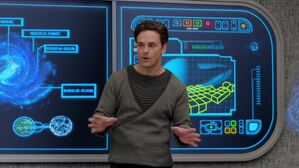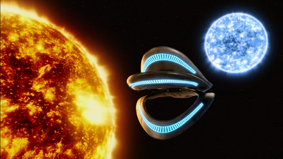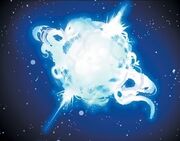
On the wall behind Cassius are a map of the Milky Way galaxy (left) and a star chart (right).
In the vast emptiness of the universe, we have found a fullness of cultural diversity. And when a first contact unfolds like this, the cosmos becomes a living, breathing organism. So that within that emptiness, we become a way for the universe to know itself.— Ed Mercer to the Regorians[1]
The Universe, or the cosmos,[2] was all of space and time and their contents, including planets, stars, galaxies, and all other forms of matter and energy.
While the Universe contained untold billions of galaxies, the Planetary Union divided its own Milky Way galaxy into quadrants, which were subdivided by sectors. Exact locations within a sector were indicated by positional coordinates and marks.
Galaxy
There are billions of planets in our galaxy, and we've barely charted a fraction of them.— Captain Ed Mercer[3]
The Milky Way galaxy contained billions of planets, including Earth and all the worlds of the Planetary Union. The size of the Milky Way galaxy was enormous even to civilizations capable of faster-than-light travel, and as of 2420, the Union had barely charted a fraction of its planets.[4]
The Milky Way was roughly 100,000 light years in diameter, a distance which the quantum drive of the USS Orville could cross in 10,000 hours or 416.6667 days, about a week short of a year and two months.
The Milky Way galaxy was replete with complex and sentient life. According to Talla Keyali, the Union was aware of thousands of different cultures.[5]
Quadrants
So, how many ships in the fleet these days?"— Gordon Malloy and Ed Mercer[6]
"About 3,000, spread over the whole quadrant, which, when you think about the size of the galaxy, is actually not - What is that? Is that a beer?
In stellar cartography, a quadrant was major region of space encompassing one-fourth of a galaxy. Quadrants were sub-divided into units called sectors.[7]
The quadrants of the Milky Way galaxy have not been explicitly delineated. It is believed that the quadrants were named Alpha, Beta, Delta, and Gamma, and subdivided into smaller units known as "marks," based on the reported coordinates of the USS Druyan as "3-1-9 alpha, mark 7."
Alpha Quadrant
Geography
Similar to the rest of the galaxy, the Alpha Quadrant was filled with stars and their satellites. Three civilizations covered large swathes of space: the Planetary Union, the Krill, and the Chak'tal (the latter of which little is known).
The Union and the Krill's territories often abutted each other - but not always. For example, when Doctor Darden manipulated the Orville's navigational array, the ship immediately crossed from Union space into Krill space.[8] However, at other places in space, there were gaps in their border which neither the Union nor the Krill claimed. For example, somewhere between the Union and Krill territories was a dangerous pocket of unclaimed space with a two-dimensional spatial anomaly.[9]
About one day's travel from the Gatria system was a stable wormhole connecting the 29th century to the 25th, destroyed in 2419, which was five days away was Union Outpost 49.[10] Earth was 182 light years from Gatria,[11] between 58 and 422 light years from the wormhole, and between 778 and 1,622 light years from from Outpost 49.
8,750 light years from Earth was Outpost 23.[12] Between 8,750 and 9,000 light years from Earth was the Chog homeworld. Up to 250 light years from the Chog homeworld and 9,000 light years from Earth was the magnetar AXP 1E 1048-59.[13]
The Epsilon system (including Epsilon 2) was about 2.5 light years from Sensoria 2 and half of a light year from an unnamed planet where Ed and Teleya fled from the Chak'tal.[14]
Civilizations
Planetary Union territory spread throughout one quadrant with numerous member species including Humans, Xelayans, Moclans, Retepsians, and Gelatins and many colony planets. Another major power in the same quadrant was the Krill, an aggressive reptilian humanoid species who hailed from a nearby, but unspecified home world.
Other major civilizations of the quadrant included the Kaylon, Calivon, Navarians, Bruidians, Chak'tal, Janisi, and myriad unnamed species. The outskirts of the quadrant were inhabited by other species but uncharted by the Union, and were considered the "frontier" of space.
By the 29th century, a species known as the Benzians became known in that quadrant of the galaxy.[10]
Systems

The Septar binary star system
- Alibar system - Contained Alibar, the "Construct," and what appear to be five or six other satellites.[15]
- Delta Pavonis - Home to a museum which received the Saratoga Springs time capsule from the Orville. Doctor Sherman stated that the Delta Pavonis Museum had been "itching" for its arrival.[16]
- Epsilon system - Consisted of at least two inhabited planets including Epsilon 2 and Epsilon 5.
- Epsilon Eridani - Commander Ed Mercer was commuting to Epsilon Eridani for work every day in 2418.[17]
- Gamma Velorum system - Contained seven planets, including Regor 2.[5]
- Gatria system - Hosted deposits of dysonium. Pria Lavesque was stranded on a sun diver, a moribund comet about to collide with Gatria's sun.[10]
- Izar system - Home to the Janisi.[5]
- Kaylon system - Contained the planet Kaylon 1.[4]
- Lakkar B - Distant to Union space, this system contained the Envall homeworld.[18]
- Matar system - Hosted mineral deposits mined by the Vega Mining Consortium.[10]
- Nekkar system - The Orville took the engineer Toren to a research vessel in the Nekkar system.[19]
- Septar binary system - A pair of stars consisting of the primary, a type B7 white dwarf star, and the secondary, a type M2 red dwarf. The radial velocity of the white dwarf was 89.6 kilometers per second.[20]
- Solar system - Consisted of a star known as Sol or the Sun and eight planets, including Earth. Site of the Battle of Earth in February 2421.
- An unnamed K-type star system hosted three planets in orbit. The innermost planet was habitable and colonized by Moclan females, establishing "The Sanctuary."[19]
- Vendek system - Contained the planet Vendek 2.[17]
There are several unidentified star systems as well:
- An unidentified star system lied within a class-six absorption nebula, consisting of a K-type star with three planets in orbit, including "The Sanctuary."[19]
- An unidentified star system within Planetary Union space, its fourth planet was habitable.[14]
Planets
- Arboreus Prime - Renowned as a vacation planet with rides, entertainment, and hotels that floated in the sky. Doctor Claire Finn, her sons Ty and Marcus, and Isaac meant to visit the planet for a holiday but their shuttle was sucked into the gravity well of a Class-2 spatial fold. A dockmaster on the planet reported to the Orville that they never arrived.[10]
- Calivon - Home of the Calivon species.[21][22]
- Chara 3 - Host of a former Union colony, destroyed in a Krill raid for its resources.[23]
- Deneb 3 - A planet mentioned by simulations of Ed's parents, Bert and Jeannie Mercer, as their weekend getaway destination.[21]
- Earth - Home of the human species. Host world of Planetary Union Central in New York City. Orbited by the Union Dockyard and the Moon, its lone permanent natural satellite.[24]
- Elnath 4 - A planet saved from an asteroid by the Orville in October 2419. Were it not for the Orville's "cutting beam," the asteroid would have collided in one month, 17 days.[25]
- Envall homeworld[18]
- Epsilon 2 - Host of the famous Epsilon Science Station, known for the technological breakthroughs of its scientists.[24]
- Epsilon 5 - A Union colony.[14]
- Kastra 4 - A Union mining colony.[23]
- Kaylon 1 - Home of the Kaylon species.[24]
- Krill - Home of the Krill species. A world of "perpetual night," shrouded in cloud cover that obscures 96 percent of sunlight from the planet's surface.[23]
- Lopovius - Colony planet of both the Navarians and Bruidians.[26]
- Moclus - Home of the Moclan species.[25]
- Mizar 2 - A planet home to a primitive culture. Union xenoanthropologists Darden, Karx, Franz and Celeste were assigned to study this culture in summer 2420, only to take their Union transport vessel into Krill space.[8]
- Nazh - Home of the Nazh species.[27]
- Nyxia - Home of the Nyxian species. Destroyed in August 2420 by its own star.[28]
- Rana 3 - A Union farming colony.[23]
- Regor 2 - Home of the Regorian species.[5]
- Retepsia - Home of the Retepsian species.[19]
- Rhealon 4 - While a Union Point cadet, Kelly Grayson was aboard a ship breaking gravity on Rhealon 4.[17]
- "The Sanctuary" - A secret refuge of Moclan females.[19]
- Sargus 4 - Host of the Sargun species.[29]
- Sensoria 2 - A holiday excursion spot located two light years from Epsilon 5.[14]
- Vendek 2 - A planet with a covariant ring system which was used by the Orville to elude a pair of Kaylon Spheres.[17]
- An unnamed terrestrial planet that was the refuge of Ed and Teleya from the Chak'tal in 2420. About half of a light year from Sensoria 2 and 2.5 light years from Epsilon 5.[14]
- An unnamed gas giant orbited by 32 moons, including a habitable moon landed upon by Claire, her children, and Isaac.[10]
- Xelaya - Home of the Xelayan species.[30]
In addition to the list below, there was an unidentified planet as well:
- Pria Lavesque said there was a planet on the frontier where business negotiations began by showing their genitals.[10]
Cosmic and stellar bodies

The magnetar.
- J-2837 (star) - On the edge of the frontier of charted space. When discovered in late October 2419, the Bio-ship was on course to collide with the star in six months time.[31]
- Ed says there are no space stations nearby.[31]
- Giliac - A star in this constellation collapsed into a black hole in 702 BCE.[5]
- Class-2 Spatial Fold - An aperture spanning 1,000 light years across.[10]
- Two-dimensional space - Host of two-dimensional beings. Located in space at 3-4-8, mark 9-14.[9]
- Temporal wormhole between the 25th and 29th centuries (destroyed November 2419)[10]
- AXP 1E 1048-59 (magnetar) - A neutron star with a very powerful magnetic field. Isaac spent a few days investigating this star in June 2420. According to Gordon, the magnetar was too boring to have been given a name.[13] This magnetar is roughly 9,000 light years from Earth.
- Black hole located somewhat near a Resistance base which was in the process of assuming the debris of a recently destroyed planet.[22]
Space stations
- Outpost 23 - Ed Mercer and Gordon Malloy were to brief a tactical conference on their experiences aboard the Yakar at this outpost in June 2420.[13]
- This outpost is roughly 8,750 light years from Earth.[12]
- The outpost sent a message to the Orville that Ed and Gordon never arrived. (The two had crash-landed on the Chog homeworld.)[32]
- Outpost 30 - Having completed its analysis of the Septar binary system, the Orville set course for this outpost in December 2420.[20]
- Outpost 49 - Roughly five days journey from the Gatria system or up to 1,622 light years from Earth. The Orville nearly stopped for repairs in November 2419.[10]
- Outpost 58 - The Orville picked up their new dark matter cartographer, Lieutenant Janel Tyler, from this outpost. The Orville stopped at the outpost on its way to the planet Moclus.[33]
- The outpost has four docking wings, each with a Shuttle Bay.
- Outpost 73 - Gordon Malloy and Orrin Channing, both in their early twenties, were stationed on this outpost in c. 2400. Orrin was living there with his wife Sophie and their newborn daughter Leyna when the Krill made a surprise attack on the outpost. Orrin's wife and daughter were killed, and he himself was captured by the Krill after saving Gordon's life.[18]
- Outpost T85 - Admiral Halsey recall tedhat Gordon Malloy drew a penis on its main viewing screen.[24]
- Station 794 - Where Kelly Grayson was picked up by the Orville when she first joined as its Commander. Ed says it is "barely out of the way" of a journey from Earth to Epsilon 2.[24]
- "Moclan Dockyard" - Similar to the Union Dockyard, this facility in orbit of Moclus services vessels of both the Union Fleet and the local Moclan Fleet.
- Epsilon Eridani outpost - Located in Epsilon Eridani, Ed Mercer was the Commanding Officer of this outpost in an alternate timeline.[22]
Additionally, there were unidentified stations:
- Steve Newton transferred off the Orville to design a space station.[9]
- Orrin Channing met an Envall woman at an unnamed outpost.[18]
Alternate timeline
In an alternate timeline in which the Kaylon won the Battle of Earth, they proceeded to wipe out half the known galaxy in less than nine months in 2421 as part of their campaign to exterminate all biological lifeforms.
Other galaxies
Based on the navigational bridge screen of the USS Orville, several galaxies are known to be used as reference points to coordinate the ship's relative position, they are CGCG-161, IC 6041-B, KUG 1285, NGC 4854, and NSC 4926A.[34]
Other realities
- A two-dimensional space was discovered by the USS Orville in late 2419.[9]
- Soon after, the Orville discovered a planet which uniquely existed in a multiphasic orbit. While relatively spending the majority of its existence in another universe, this planet periodically appears in our universe for a few days before returning to the other, where 700 years pass before it returns to our universe, only 11 days later from the Orville's perspective.[35]
Production
Originally, creator Seth MacFarlane envisioned the Planetary Union to encompass more of the Milky Way galaxy, which is reflected in an early draft of Old Wounds where Ed states that the Union Fleet is spread over two quadrants. This was scaled back to one quadrant in the final version.
Trivia
- The Regorians viewed the Universe as ordered and determined, which is why they strictly followed an astrological system to find meaning. "So you all just think the universe is chaos?" the First Prefect said to Ed. "No order? No significance to anything? I wouldn't want to be part of a community that believes that."[5]
References
- ↑ Episode 2x05: All the World is Birthday Cake
- ↑ Ed Mercer calls it both in All the World is Birthday Cake.
- ↑ Episode 2x08: Identity, Pt. 1
- ↑ 4.0 4.1 Episode 2x08: Identity, Pt. 1
- ↑ 5.0 5.1 5.2 5.3 5.4 5.5 Episode 2x05: All the World is Birthday Cake
- ↑ Episode 1x01: Old Wounds
- ↑ Ed: "There shouldn't be any Krill in this sector." Episode 2x04: Nothing Left on Earth Excepting Fishes
- ↑ 8.0 8.1 Episode 1.5x03: The Word of Avis, Pt. 1
- ↑ 9.0 9.1 9.2 9.3 Episode 1x11: New Dimensions
- ↑ 10.0 10.1 10.2 10.3 10.4 10.5 10.6 10.7 10.8 10.9 Episode 1x05: Pria
- ↑ Gatria (Gamma Trianguli Australis) Star Facts. Universe Guide. Last accessed Oct.28, 2019.
- ↑ 12.0 12.1 This is because the magnetar AXP 1E 1048-59 is 9,000 light years from Earth, from which Outpost 23 is a day's journey. The top travel speed of the Orville is over 10 light years per hour (Episode 1x05: Pria), making the outpost approximately 8,750 light years from Earth.
- ↑ 13.0 13.1 13.2 Episode 1.5x01: New Beginnings, Pt. 1
- ↑ 14.0 14.1 14.2 14.3 14.4 Episode 2x04: Nothing Left on Earth Excepting Fishes
- ↑ Episode 2.5x01: Launch Day, Pt. 1
- ↑ Episode 2x11: Lasting Impressions
- ↑ 17.0 17.1 17.2 17.3 Episode 2x13: Tomorrow, and Tomorrow, and Tomorrow
- ↑ 18.0 18.1 18.2 18.3 Episode 2x10: Blood of Patriots
- ↑ 19.0 19.1 19.2 19.3 19.4 Episode 2x12: Sanctuary
- ↑ 20.0 20.1 20.2 Episode 2x06: A Happy Refrain
- ↑ 21.0 21.1 Episode 1x02: Command Performance
- ↑ 22.0 22.1 22.2 Episode 2x14: The Road Not Taken
- ↑ 23.0 23.1 23.2 23.3 Episode 1x06: Krill
- ↑ 24.0 24.1 24.2 24.3 24.4 Episode 1x01: Old Wounds
- ↑ 25.0 25.1 Episode 1x03: About a Girl
- ↑ Episode 1x09: Cupid's Dagger
- ↑ Episode 2.5x04: Heroes, Pt. 2
- ↑ Episode 2x02: Primal Urges
- ↑ Episode 1x07: Majority Rule
- ↑ Episode 1x10: Firestorm
- ↑ 31.0 31.1 Episode 1x04: If the Stars Should Appear
- ↑ Episode 1.5x02: New Beginnings, Pt. 2
- ↑ Episode 2x01: Ja'loja
- ↑ @TomCostantino. "MORE - I was bored waiting on the bridge so I took this random picture @TheOrville S3. @joncassar 🎥@planetary_union @hulu 🚀👽🎬@SethMacFarlane #TheOrville👾". Twitter. Oct. 17, 2019.
- ↑ Episode 1x12: Mad Idolatry
